Research
In aquaculture, production efficiency faces common problems in terms of achieving ideal growth conditions, maintaining rapid growth, and ensuring a healthy organism until harvest. Central to achieving conditions ideal for growth is an understanding of the impacts of how environmental conditions and handling practices stress the culture organism and how to modify practices to create favorable conditions and alleviate unnecessary stress. Culture organisms are generally grown under conditions that they did not evolve under, either by confinement, crowding, elevated temperature, or the impacts of prolonged maximal growth. Further, handling practices can result in elevated stress responses with either acute effects of poor health, shock or mortality or long-term effects of reduced growth. The effects of environmental conditions and handling practices are often not well-understood. An example is the thermal regimes encountered by catfish in culture ponds during summer months. Although a number of laboratory based studies exist, little is known in regard to temperature conditions fish actually experience in ponds. Further, fish are more often subjected simultaneously to multiple stressors such as temperature, dissolved oxygen and nitrogenous wastes, although little is known of the synergistic or cumulative impacts. In order to maximize production efficiency and reduce disease susceptibility, these effects need to be studied, and production would benefit from analyses on both channel catfish and hybrid catfish (female channel catfish x male blue catfish).
Further, culture organisms are continually faced with parasites and disease agents. Because of the high densities maintained in aquaculture, the spread of these disease agents can be rapid and very expensive to the farmer. An understanding of the physiological effects of these agents on the health and homeostatic mechanisms of the culture organisms can have far reaching economic benefits to the farmer. New disease agents continue to be discovered and diagnosed. A relatively recent parasite that has had an economic impact on catfish culture is the trematode Bolbophorus confusus.
The national economic recession, increases in imported catfish and tilapia, and increases in grain costs have led to a reduction in aquaculture production in Mississippi. As a result, up to 40% of ponds previously used for catfish production are now fallow. Diversification of any market is always a good idea for long-term stability, but has become particularly evident for the Mississippi aquaculture industry during the recent economic recession. Finding species that can be cultured in currently existing ponds with minimal additional costs to farmers, and that utilize a different market than catfish, would be a big boon to aquaculture production.
Neuropeptide Regulation of Appetite during Hypoxia in Channel Catfish
Brian Ott
In aquaculture, production efficiency faces common problems in terms of achieving ideal growth conditions, maintaining rapid growth, and ensuring a healthy organism until harvest. Central to achieving conditions ideal for growth is an understanding of the impacts of how environmental conditions and handling practices stress the culture organism and how to modify practices to create favorable conditions and alleviate unnecessary stress. Culture organisms are generally grown under conditions that they did not evolve under, either by confinement, crowding, elevated temperature, or the impacts of prolonged maximal growth. Further, handling practices can result in elevated stress responses with either acute effects of poor health, shock or mortality or long-term effects of reduced growth. The effects of environmental conditions and handling practices are often not well-understood. An example is the thermal regimes encountered by catfish in culture ponds during summer months. Although a number of laboratory based studies exist, little is known in regard to temperature conditions fish actually experience in ponds. Further, fish are more often subjected simultaneously to multiple stressors such as temperature, dissolved oxygen and nitrogenous wastes, although little is known of the synergistic or cumulative impacts. In order to maximize production efficiency and reduce disease susceptibility, these effects need to be studied, and production would benefit from analyses on both channel catfish and hybrid catfish (female channel catfish x male blue catfish).
Understanding Red Fillet in the Catfish Industry
Shay Allred
Channel Ictalurus punctatus and Hybrid I. furcatus x I. punctatus Catfish currently account for 51% of all food-fish aquaculture in the United States. Catfish health and fillet quality are important to sustaining production, since loss at the farm or rejection of fillets by processors reduces the already thin profit margins for producers. Nonstandard Channel and Hybrid Catfish fillets are rejected by catfish processors due to aberrations in muscle texture or coloration (i.e., red), and represent an economic loss for both the processer and farmer. Red fillet is characterized by red coloration, with affected areas ranging from a solitary spot to the whole fillet. Small, singular red discoloration marks could be caused by neighboring catfish locking their pectoral fins which can lead to puncture damage. Blotchy, red coloration is hypothesized to be the result of internal hemorrhaging caused by stressful stimulus; although, underlying causes have not been conclusively identified. Samples of red fillets were obtained from a local processing plant and assessed for proximate analysis, microbial presence, and muscle histology. Further experimentation exposed catfish to poor water quality conditions or bacterial inoculation where changes in blood physiology and fillet colorimetry and proximate analysis were documented.
Outputs of this study include:
- Assessing pond water quality in commercial catfish culture pre-and post-seine and during socking and hauling procedures.
- Determining the prevalence of red fillet within the catfish industry and quantitatively assess the relative abundance of blotchy and punctured red fillets while evaluating fillet composition differences based on color, pH, proximate composition, and microbial presence.
- Determining the influence of acute exposure to stressful water and harvest conditions on fillet quality by assessing induced stress responses and proximate analysis.
- Determining the physiological response Channel Catfish exhibit after inoculation with A. veronii biovar sobria and assessing whether infection will induce blotchy, red fillet.
Culture Techniques and Evaluation of Snail Consumption in Black Buffalo, Ictiobus niger
Emmet Guy
Black Buffalo (Ictiobus niger) are a non-game species of fish native throughout the Mississippi River basin. Like many species in the family Catostomidae (more commonly known as “suckers”), Black Buffalo have experienced population declines and are listed as a species of concern in several states including Mississippi. Artificial propagation may be needed to help recover the species if population levels continue to decline. This project aims to develop culture techniques to aid in the rearing of Black Buffalo. Further, an increasing number of suckers are being recognized as imperiled and, due to the lack of existing literature on techniques for culturing suckers, results from this research could benefit conservation efforts of other sucker species by outlining successful culture methods. Additionally, it is believed Black Buffalo feed on a variety of invertebrates and mollusks and, therefore, there is potential for Black Buffalo to be used as a snail control option in commercial catfish ponds. Snails are an intermediate host in the life cycle of trematodes which infect snails and secondly catfish, resulting in increased mortality and reduced growth.
An evaluation of commercial-scale low-salinity culture protocols for Gulf Killifish (cocahoe minnows, bull minnows)
Brittany Chesser
The aim of this research is to identify and evaluate setbacks in commercial-scale low-salinity production of a popular marine bait fish, the Gulf Killifish or cocahoe minnow (Fundulus grandis). More specifically, this research will guide inland Mississippi growers in their production of this species and help identify which protocols are more feasible depending on production goals. Survival, growth, relative weights, and production parameters will be documented.
Development of Techniques for Spawning, Sperm Cryopreservation, and Feed-Training of Crappie (Pomoxis spp.)
Christian Shirley
Crappie (Pomoxis spp.) are one of the most sought-after game fish throughout the Southeastern United States. Despite their popularity, crappie present unique management challenges to biologist, including overpopulation of smaller impoundments, and have variable annual recruitment, produce strong year classes every 3-5 years. In attempts to address these issues, supplemental stocking of hatchery-reared crappie are often stocked into public waters by management agencies. However, the intensive production of crappie that is used to supply the stocking programs is relatively new, with little information regarding intensive spawning and rearing techniques. The aim of this study is to refine and optimize intensive spawning and production techniques including: identifying and understanding the effects of an ovulation rimw window in White Crappie (Pomoxis annularis), develop sperm cryopreservation techniques for black-stripe Black Crappie (Pomoxis nigromaculatus), compare the effects of different sex ratio tank holding procedures on out-of-season spawning success, and develop techniques for rearing and feed training larval crappie indoors.
Low Input shrimp culture: understanding production and nutrient dynamics
Peter Allen
Research is interested in identifying nutrient dynamics in low-input shrimp cultures. The low-input culture system lends itself to a reduced feed allocation and relies on natural periphyton and phytoplankton production to sustainably supplement feed for developing shrimp. It is important to understand how feed inputs contributes to overall nutrient budgets within the system, and how feeding regimes (i.e. control, 30% less, 60% less) affect water quality within the pond, effluent mitigation, as well as the production weight of shrimp.
Seasonally elevated temperature effects on bioenergetic responses of juvenile channel catfish Ictalurus punctatus
Peter Allen
The goals of this study are to observe the effects of increased temperatures on several aspects of channel catfish (Ictalurus punctatus) physiology. While much research has been performed regarding overwintering effects of feeding and growth on channel catfish, surprisingly little has been conducted involving summertime temperatures (24 -36°C). By utilizing specific heating regimes in flow-through aquaculture systems, three treatments of fingerlings will be subjected to differing levels of elevated ambient temperatures intended to mimic natural conditions found in farm ponds. The outputs of this study will include:
Effects of salinity acclimation on growth, metabolic rate and ion regulation of juvenile alligator gar Atractosteus spatula
Peter Allen
The goal of this study is to determine how juvenile alligator gar Atractosteus spatula are able to survive in different salinities (0, 8, 16, and 24 ppt) at two different ages (60 and 330 days after hatch). This species is known to spawn in freshwater (< 8 ppt) and adult alligator gar have been found in estuarine environments as well as full strength seawater (34 ppt). However there has been little information provided on how the physiology of the species enables it to survive in different salinities. Euryhaline fish have necessary osmoregulatory abilities that enable them to regulate their internal ion concentrations to maintain homeostasis. If alligator gar can survive in different salinities then it would be beneficial to know what mechanisms they are using to maintain homeostasis. To this end, the outputs of this study will include the following:
An evaluation of the effects of diet and salinity on survival and growth of larval to juvenile cocahoe minnows Fundulus grandis
Peter Allen
This study utilizes a variety of the South Farm systems including the newly installed indoor hatchery/nursery facilities, the earthen research ponds, and the mesocosm facility. The aim of this research will be to identify critical production parameters in the production of a popular marine bait fish, the cocahoe minnow (Fundulus grandis) relative to low salinity commercial production. More specifically this research will seek to determine if these minnows can be produced by inland Mississippi growers utilizing existing water sources and production equipment and facilities. Survival, growth, relative weights, and production parameters will be documented. The outputs from this study will include:
Thermal Stress Tolerance in Channel and Hybrid Catfish Strains
Peter Allen
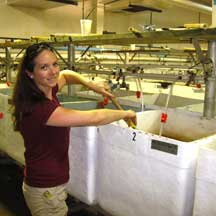 This study utilizes a variety of the South Farm systems including the newly installed indoor hatchery/nursery facilities, the earthen research ponds, and the mesocosm facility. The aim of this research will be to identify critical production parameters in the production of a popular marine bait fish, the cocahoe minnow (Fundulus grandis) relative to low salinity commercial production. More specifically this research will seek to determine if these minnows can be produced by inland Mississippi growers utilizing existing water sources and production equipment and facilities. Survival, growth, relative weights, and production parameters will be documented. The outputs from this study will include:
This study utilizes a variety of the South Farm systems including the newly installed indoor hatchery/nursery facilities, the earthen research ponds, and the mesocosm facility. The aim of this research will be to identify critical production parameters in the production of a popular marine bait fish, the cocahoe minnow (Fundulus grandis) relative to low salinity commercial production. More specifically this research will seek to determine if these minnows can be produced by inland Mississippi growers utilizing existing water sources and production equipment and facilities. Survival, growth, relative weights, and production parameters will be documented. The outputs from this study will include:
Understanding important early life history influences on paddlefish Polyodon spathula
Peter Allen
Paddlefishes are among the most ancient freshwater fishes, having been in existence for over 150 million years. The North American paddlefish (Polyodon spathula; paddlefish) is considered one of the largest of the freshwater fishes, growing to a size of over 2.2 m and weighing up to 72 kg in its lifetime. Paddlefish support a recreational fishery in much of their distribution and a limited commercial fishery in some areas. Culture of this species provides both caviar and filet products. Unfortunately, the overall population status of this species is in decline. Successful long-term recovery of declining paddlefish populations will have to involve stocking strategies that incorporate an understanding of survival at early life history stages and the processes that guide spawning movements. Paddlefish are known to have spawning site fidelity and it is hypothesized that imprinting, the process whereby fishes retain a chemical signature of their natal habitat, is a major factor driving this. However, relatively little is known about the optimal sizes of fish that are stocked for survival, and whether the timing and location of stocking are important for imprinting on spawning areas and kin recognition. Further, one of the important factors relating to survival is how paddlefish respond to hypoxia. This study is therefore directed at understanding the mechanisms of imprinting and their developmental timing and hypoxia-related survival at various life history stages.
The effects of cumulative stressors on physiology and quality of channel catfish
Peter Allen
Channel catfish (Ictalurus punctatus) represent a significant resource in the Southern United States and the primary farm raised species in the US. They are typically cultured in shallow ponds, which can result in drastic environmental changes. Culture techniques such as sorting, grading and transport can cause additional stress during harvest. The accumulation of stress events can result in physiological changes that may alter the quality of the fillets produced. This study was designed to evaluate the effects of cumulative stressors on physiology and fillet quality in channel catfish. To elicit a stress response similar to what may be observed in pond culture fish were subject to a combination of environmental stressors including temperature (25°C or 33°C) and dissolved oxygen (i.e. 2mg/L or 6mg/L), followed by handling stressors including socking, sorting and transport at high densities. Subsamples will be taken at the culmination of each stress event for physiological and quality evaluation. The objectives of this study are to address the following with regard to different cumulative stress events:
- To evaluate the physiological stress response (blood glucose, cortisol, lactate, pH and proteome) in live channel catfish due to cumulative stressors including dissolved oxygen content, temperature and handling.
- To determine the effects of stress on channel fillet yields
- To evaluate changes in rigor mortis and the expression of sarcoplasmic and myofibrillar proteins in catfish fillets as the fish progress through the stress events.
- To evaluate quality, sensory properties and consumer acceptability of catfish fillets following stress.
- To examine correlations between fillet quality post-stress and the presence of pathogenic microorganisms such as Listeria monocytogenes and Salmonella typhimirium.
- To identify any relationships that exist between live animal treatments, stress indicators, muscle proteomes, meat quality measurements and sensory testing using multivariate statistical techniques, including principle component analysis, cluster analysis and preference mapping.
Efficacy of tailwater recovery systems as an approach to water resource conservation
Austin Omer
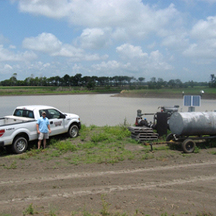 The need for intense agricultural practices in the Lower Mississippi Alluvial Valley has faced producers with two predominant environmental issues. First, agricultural practices have resulted in increased transport of nutrients to receiving waters. Second, current water withdrawals from the Mississippi Alluvial Aquifer for irrigation are not sustainable. These issues necessitate the use of best management practices and ground water conservation. My research focuses on irrigation conservation practices including tail water recovery, on-farm storage and the use of innovative technologies, such as irrigation meters. Currently surface water capture systems are on the ground in Mississippi, however, efficiencies of these systems as a method of water resource conservation are not yet quantified. The main objectives of my research include assessing nutrient loads leaving agriculture catchments containing a gradient of different management practices, determine the capability of tail water recovery to mitigate nutrient loss, and describe the benefits of tail water recovery through water harvesting budgets, nutrient cycling budgets, and economic analyses. The findings of this research will provide valuable outreach material to disseminate to producers across Mississippi.
The need for intense agricultural practices in the Lower Mississippi Alluvial Valley has faced producers with two predominant environmental issues. First, agricultural practices have resulted in increased transport of nutrients to receiving waters. Second, current water withdrawals from the Mississippi Alluvial Aquifer for irrigation are not sustainable. These issues necessitate the use of best management practices and ground water conservation. My research focuses on irrigation conservation practices including tail water recovery, on-farm storage and the use of innovative technologies, such as irrigation meters. Currently surface water capture systems are on the ground in Mississippi, however, efficiencies of these systems as a method of water resource conservation are not yet quantified. The main objectives of my research include assessing nutrient loads leaving agriculture catchments containing a gradient of different management practices, determine the capability of tail water recovery to mitigate nutrient loss, and describe the benefits of tail water recovery through water harvesting budgets, nutrient cycling budgets, and economic analyses. The findings of this research will provide valuable outreach material to disseminate to producers across Mississippi.
Development of Crappie (Pomoxis spp.) Reproduction Methods in Closed Aquaculture Systems
Charlie Culpepper
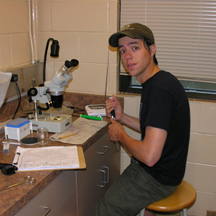 Crappie (Pomoxis spp.) represent some of the most important regional gamefishes in the Southeast, however populations are cyclic and difficult to manage. In order to increase population stability, spawning and culture of crappie have been conducted by the North Mississippi Fish Hatchery in Enid, MS. However, techniques have been hampered by the paucity of available information. In order to develop crappie reproduction methods in closed aquaculture systems, the following reproductive experiments are being conducted:
Crappie (Pomoxis spp.) represent some of the most important regional gamefishes in the Southeast, however populations are cyclic and difficult to manage. In order to increase population stability, spawning and culture of crappie have been conducted by the North Mississippi Fish Hatchery in Enid, MS. However, techniques have been hampered by the paucity of available information. In order to develop crappie reproduction methods in closed aquaculture systems, the following reproductive experiments are being conducted:
- Develop a protocol for the cryopreservation and activation of white crappie (Pomoxis annularis) sperm.
- Evaluate the viability of induced spawning methods in white crappie (Pomoxis annularis).
- Assess the potential for out-of-season spawning in white crappie (Pomoxis annularis) using photoperiod and temperature manipulation.
Estimation of angling mortality in the development of live well management procedures to improve the survival of Largemouth Bass
Kevin R. Keretz, M.S. student
Largemouth Bass Micropterus salmoides is the most sought after species by recreational anglers in the United States. Survival of angled and tournament-handled Largemouth Bass is related to numerous factors; however, the independent effects of water temperature, angling time, and live well dissolved oxygen concentration on survival have not been measured. Survival was evaluated in simulated catch and release and tournament trials over the range of temperatures encountered by Largemouth Bass anglers (17-33°C) while also testing independent effects of angling time, live well temperature, and live well dissolved oxygen treatments. Caught-and-released Largemouth Bass experienced 100% survival at temperatures ≤33°C after 1 minute of angling, but survival decreased with additional angling time. Survival declined in tournament-handled fish at 33°C; however, high survival was shown to be possible at ≤29°C after 1-minute angling time, confinement in live wells containing less than ambient temperatures and dissolved oxygen ≥5.5 mg/L, and organized in-water weigh-in procedures.
The physiological effects of temperature, dissolved oxygen content and handling time on the recovery of largemouth bass (Micropterus salmoides) from simulated angling stress
Colin Dinken, M.S. student
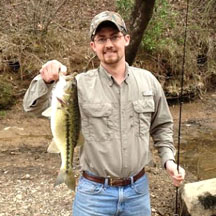 The Largemouth Bass Micropterus salmoides is a popular sportfish amongst recreational anglers, many of whom practice catch-and-release or compete in tournaments that require live release after weigh-in. Although high survival of caught-and-released Largemouth Bass is often assumed, tournament-caught fish are susceptible to numerous stressors which may impact mortality. These stressors include ambient water temperature, exhaustive exercise during angling, live well retention, and the weigh-in procedure. Therefore, the effects of ambient temperature (T = 17, 25, 33 °C), simulated angling, and live well retention were measured in a controlled study for up to eight hours on multiple stress indicators in Largemouth Bass. In addition, the effects of ambient temperature (T = 17, 25, 33 °C) and live well temperature differentials (ΔT = −4, 0, and +4 °C) were measured on the stress response and post-stress recovery of adult Largemouth Bass subjected to simulated angling and tournament handling.
The Largemouth Bass Micropterus salmoides is a popular sportfish amongst recreational anglers, many of whom practice catch-and-release or compete in tournaments that require live release after weigh-in. Although high survival of caught-and-released Largemouth Bass is often assumed, tournament-caught fish are susceptible to numerous stressors which may impact mortality. These stressors include ambient water temperature, exhaustive exercise during angling, live well retention, and the weigh-in procedure. Therefore, the effects of ambient temperature (T = 17, 25, 33 °C), simulated angling, and live well retention were measured in a controlled study for up to eight hours on multiple stress indicators in Largemouth Bass. In addition, the effects of ambient temperature (T = 17, 25, 33 °C) and live well temperature differentials (ΔT = −4, 0, and +4 °C) were measured on the stress response and post-stress recovery of adult Largemouth Bass subjected to simulated angling and tournament handling.
Investigating the link between stress, temperature, and metabolic inertia in largemouth bass Micropterus salmoides
Shelby Mathieu, Undergraduate research project
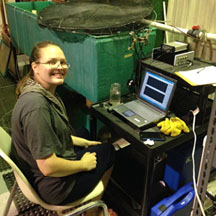 In an ectotherm, what is the time lag for metabolic adjustment following an acute temperature-induced stress event? My undergraduate research project is looking at the effects of an acute change in temperature on the metabolic rate of largemouth bass. The bass are acclimated for 2-3 weeks at either 20 or 30°C and then transferred to a holding tank with a respirometer. The fish are then placed in the respirometer and transferred to a second tank. Temperature is rapidly adjusted at the same time metabolic rate is measured. We expect to learn more about the stress response in largemouth bass, how the stress response is affected by a change in temperature, and how these factors affect the short-term survival rate of largemouth bass.
In an ectotherm, what is the time lag for metabolic adjustment following an acute temperature-induced stress event? My undergraduate research project is looking at the effects of an acute change in temperature on the metabolic rate of largemouth bass. The bass are acclimated for 2-3 weeks at either 20 or 30°C and then transferred to a holding tank with a respirometer. The fish are then placed in the respirometer and transferred to a second tank. Temperature is rapidly adjusted at the same time metabolic rate is measured. We expect to learn more about the stress response in largemouth bass, how the stress response is affected by a change in temperature, and how these factors affect the short-term survival rate of largemouth bass.